
Golden software surfer programming language - message, matchless)))
Page Content
![]() Surfer 12 (Golden Software)
Surfer 12 (Golden Software)
![]() Contour Maps
Contour Maps
![]() Base Maps
Base Maps
![]() Vector Maps
Vector Maps
![]() Profiles
Profiles
![]() Variograms
Variograms
![]() Worksheets
Worksheets
![]() 3D surface Maps
3D surface Maps
![]() Post Maps
Post Maps
![]() Map Layers
Map Layers
![]() Customize Your Map
Customize Your Map
![]() Faults and Breaklines
Faults and Breaklines
![]() Object and Property Manager
Object and Property Manager
![]() Supported File Formats
Supported File Formats
![]() Image Maps
Image Maps
![]() Watershed Maps
Watershed Maps
![]() Stacking Maps
Stacking Maps
![]() Superior Gridding
Superior Gridding
![]() Grid Functions
Grid Functions
![]() Automation
Automation
![]() Shaded Relief Maps
Shaded Relief Maps
![]() 3D Wireframe Maps
3D Wireframe Maps
![]() Map Projections
Map Projections
![]() Grid Node Editor
Grid Node Editor
![]() Using USGS and SRTM Data
Using USGS and SRTM Data
![]() Additional Features
Additional Features
Surfer 12 (Golden Software)
Produced by Golden Software, Surfer 12 softwares sophisticated interpolation (eg. kriging) engine transforms your XYZ data into publication-quality maps. Surfer provides more gridding methods and more control over gridding parameters, including customized variograms, than any other software package on the market. You can also use grid files obtained from other sources, such as USGS DEM files or ESRI grid files. Display your grid as outstanding contour, 3D surface, 3D wireframe, watershed, vector, image, shaded relief, and post maps. Add base maps and combine map types to create the most informative display possible. Virtually all aspects of your maps can be customized to produce exactly the presentation you want. With help from GroundwaterSoftware.com and Golden Software's Surfer 12 software generating publication quality maps has never been quicker or easier.
Back to Page Content
Contour Maps
.png)
Display contour maps over any contour range and contour interval, or specify only the contour levels you want to display on the map. And with Surfer 12 software's easy map contouring you can add color fill between contours to produce dazzling displays of your maps or groundwater modeling, or produce gray scale fills for dramatic black and white printouts. This process transforms your data interpolation (eg.kriging) into brilliantly colored models.
Back to Page Content
Base Maps
.jpg)
Surfer 12 Software can import maps in many different formats to display geographic information, including groundwater modeling. You can combine base maps with other maps in map overlays, or can create stand-alone base maps independent of other maps on the page. You can load any number of base maps on a page for optimum manipulation of your data interpolation (eg. kriging). It is easy to overlay a base map on a contour or surface wireframe map, allowing you to diversify your mapping and display geographic information in combination with the three dimensional data.
Back to Page Content
Vector Maps
.gif)
Instantly create vector maps in Surfer 12 Software to show direction and magnitude of data at points on a map. You can perform vector mapping from information in one grid or two separate grids. The two components of the vector mapping, direction and magnitude, are automatically generated from a single grid by computing the gradient of the represented surface.
Back to Page Content
Profiles
.png)
Surfer's automatic profile tool makes it easy to visualize the change in Z value from one point to another. Simply select the map, add a profile, and draw the line on the map. Include as many points as you want in the line; it could be a simple two-point line, or a zig-zag shape. In all cases, the profile is created showing the Z value change along the length of the line. Reshape the line on the map, and the profile automatically updates.
Back to Page Content
Variograms
.gif)
Use the variogram modeling subsystem to quantitatively assess the spatial continuity of data or data interpolation (eg.Kriging). Variograms may be used to select an appropriate variogram model when gridding with the Kriging algorithm. Surfer uses a variogram grid as a fundamental internal data representation and once this grid is built, any experimental variogram can be computed instantaneously.
Back to Page Content
Worksheets
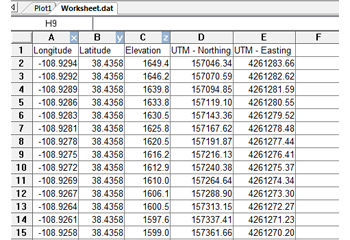
Surfer 12 Software lets you massage your data in many ways to achieve the exact output you want. Your data interpolation (eg.Kriging) can now be fully manipulated. Surfer includes a full-featured worksheet for creating, opening, editing, and saving data files. Data files can be up to one billion rows and columns, subject to available memory. You can cut, copy, and paste data within the Surfer 12 worksheet or between applications.
Back to Page Content
3D surface Maps

The 3D surface mapping uses shading and color to emphasize your data features. Change the lighting, display angle and tilt with a click of the mouse. Overlay several surface maps to generate informative block diagrams.
Back to Page Content
Post Maps
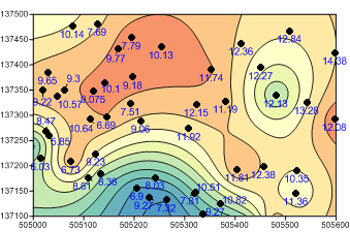
Post maps show XY locations with fixed size symbols or proportionally scaled symbols of any color. Create post maps independent of other maps on the page, or combined with other map layers. For each posted point, specify the symbol and label type, size, and angle. Also create classed post maps that identify different ranges of data by automatically assigning a different symbol or color to each data range. Post your sample locations, well locations, or original data point locations on a contour map to show the distribution of data points on the map. This demonstrates the accuracy of the gridding methods and groundwater modeling that you use.
Back to Page Content
Map Layers
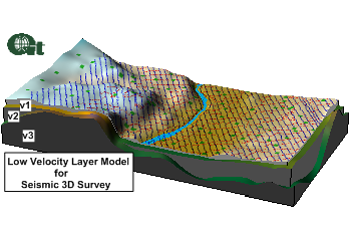
Adding multiple map layers to your map gives you a way to combine different types of data in one map. For example, you can drape a georeferenced image over a 3D surface map, overlay multiple base maps with a contour map, or plot a post map by contouring over a wireframe map. And because you can add any number of map layers to a map, you can show any amount of data on a single map. With help from GroundwaterSoftware.com and Surfer 12 (Produced by Golden Software) you are limited only by your imagination!
Back to Page Content
Customize Your Map
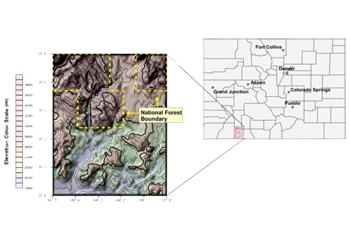
Make your map look its best by customizing it to fit your needs! Surfer 12 offers numerous map features to enhance the look of your map. Use Surfer 12s defaults, or customize your map by including scale bars, editing colors, lines and fill styles, showing only portions of a map, adjusting the scale and setting axis properties!
Back to Page Content
Faults and Breaklines
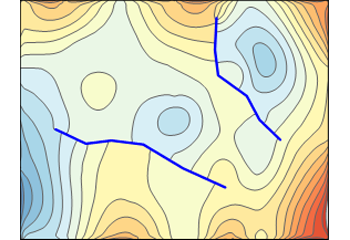
Define faults and breaklines when gridding your data. Faults act as barriers to the information flow, and data on one side of the fault will not be directly used to calculate grid node values on the other side of the fault. Breaklines include Z values. When Surfer sees a breakline, it uses the Z value of the breakline in combination with nearby data points to calculate the grid node value. Unlike faults, breaklines are not barriers to information flow and the gridding algorithm can cross the breakline to use a point on the other side to calculate a grid node value. Use breaklines to define streamlines, ridges, and other breaks in slopes. The gridding methods that support faults are: Inverse Distance to a Power, Minimum Curvature, Nearest Neighbor, and Data Metrics. The gridding methods that support breaklines are: Inverse Distance to a Power, Kriging, Minimum Curvature, Nearest Neighbor, Radial Basis Function, Moving Average, Data Metrics, and Local Polynomial.
Back to Page Content
Object and Property Manager
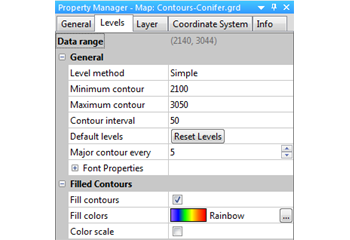
The object manager and property manager makes the editing of any object simple. The object manager displays all the objects in the plot document in an easy-to-use hierarchical tree arrangement. Double click on objects in the object manager to easily edit them, check or uncheck the check boxes next to their name to show or hide them, drag and drop objects to rearrange the order in which they are drawn, and overlay maps by dragging and dropping map layers from one map frame into another! Select any object or map layer in the object manager for easy deletion. When an object is selected in the object manager, changes to the object can be made in the property manager. The property manager is a docked window that is always displayed on the screen. You can make the property manager floating or close it, if you do not want it to display. All of the properties for an object are listed in the property manager. For instance, the Contours layer is selected in the object manager in the image below, and you can change the map contouring properties in the property manager. Once the change is made in the property manager, it is immediately applied in the plot window.
Back to Page Content
Supported File Formats
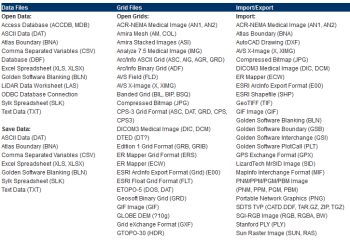
Back to Page Content
Image Maps

Surfer 12 image mapping uses different colors to represent elevations of a grid file. Surfer 12 automatically blends colors between percentage values so you end up with a smooth color gradation over the entire map. You can add color anchors at any percentage point between 0 and 100. Each anchor point can be assigned a unique color, and the colors are automatically blended between adjacent anchor points. This powerful feature allows you to create color maps using any combination of colors. Add a color scale to show the values of the different colors! Image maps can be created independently of other maps, or can be combined with other map layers. They can be scaled, resized, limited and moved.
Back to Page Content
Watershed Maps

Watershed maps automatically calculate and display drainage basins and streams from your grid file. Create colorful watershed maps to display regions draining into a stream, stream system or body of water. Display the catchment basins, streams, or both to fully integrate your groundwater modeling. Export the basins and streams to any supported file format, including SHP and DXF files, for use in other software! Surfer 12 uses the accurate eight-direction pour point algorithm to calculate the flow direction at each grid node.
Back to Page Content
Stacking Maps
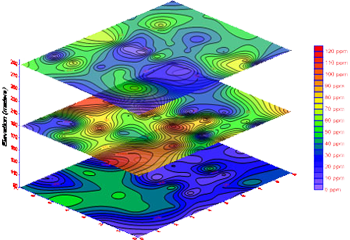
You can align individual maps horizontally on the page by stacking them. Map stacking was designed to align maps using commensurate coordinate systems. This command is useful for keeping two or more maps separated vertically on the page while keeping relative horizontal positions.
Back to Page Content
Superior Gridding
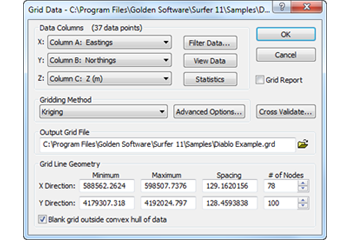
The gridding methods in Surfer 12 allow you to produce accurate contour, surface, wireframe, vector, image, and shaded relief maps from your XYZ data. The data can be randomly dispersed over the map area, and Surfer 12's gridding will interpolate your data onto a grid. Use Surfer 12s default settings for interpolating data or choose from twelve different gridding methods. Customizng your groundwater modeling has never been more simple. Each gridding method provides complete control over the gridding parameters, so you can produce exactly the map you want. If your data are already collected in a regularly spaced rectangular array, you can create a map directly from your data. Computer generated map contouring has never been more accurate.
Back to Page Content
Grid Functions
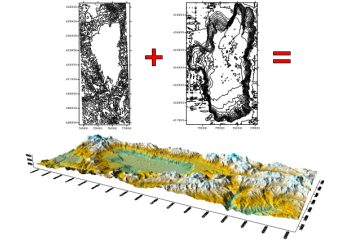
In addition to mapping and interpolating data, you can perform a variety of functions using grid files.
Back to Page Content
Automation
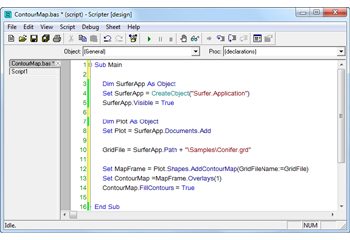
Create your own scripts to automate repetitive tasks! Dont spend time doing the same process over and over again write a simple script to simplify your life! Operations performed interactively can be controlled using an automation-compatible programming language such as Visual Basic, C++, or Perl. Surfer includes Scripter, a built-in Visual Basic compatible programming environment that lets you write, edit, debug, and run scripts. Why do more work than you need when you have Surfer working for you!
Back to Page Content
Shaded Relief Maps
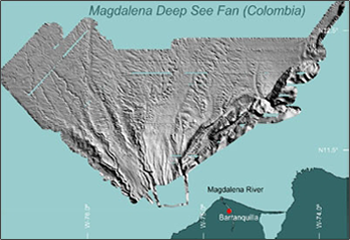
Shaded relief maps are raster images based on grid files. Colors are assigned based on slope orientation relative to a light source. Surfer 12 determines the orientation of each grid cell and calculates reflectance of a point light source on the grid surface. The light source can be thought of as the sun shining on a topographic surface. Surfer automatically blends colors between percentage values so you end up with a smooth color gradation over the map. You can add color anchors so each anchor point can be assigned a unique color, and the colors are automatically blended between adjacent anchor points. This allows you to create color maps using any combination of colors. Shaded relief maps can be created independently of other maps, or can be combined with other layers. Shaded relief maps can be scaled, resized, limited, and moved in the same way as other types of maps. With the help of GroundwaterSoftware.com your maps can be even more sophisticated than before.
Back to Page Content
3D Wireframe Maps
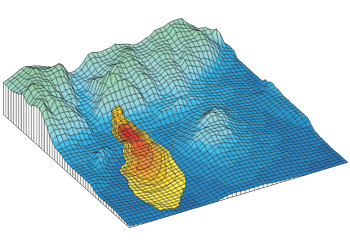
Surfer 12 wireframe maps provide an impressive three dimensional display of your data. Wireframes are created by connecting Z values along lines of constant X and Y. Use color zones, independent XYZ scaling, orthographic or perspective projections at any tilt or rotation angle, and different combinations of X, Y and Z lines to produce exactly the surface you want. Drape a color-filled contour map over a wireframe map to create the most striking color or black-and-white representations of your data. By using GroundwaterSoftware.com and Surfer 12 the possibilities are endless.
Back to Page Content
Map Projections
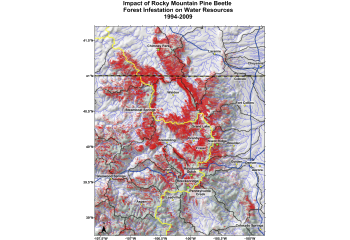
Choose from an endless list of coordinate systems for your map to display. Specify the source coordinate system for each of the layers in your map, and choose to display the map in any other coordinate system! For example, load data and grid files in UTM or State Plane coordinates, and display the map in Latitude/Longitude coordinates! It is simply that easy! Create custom coordinate systems by defining projection and datum parameters, and save the coordinate system for future use. You can also assign coordinate system information to your grid or data file and save it as an external file for future reuse.
Back to Page Content
Grid Node Editor
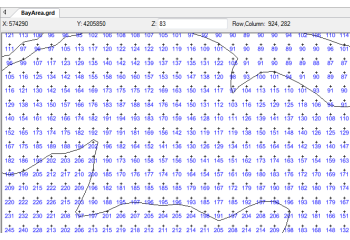
Clean up your grid with the grid node editor! Surfer's powerful grid node editor allows you to view and edit each individual grid node in a grid file. You can edit the grid node's Z value simply by selecting a grid node and entering a new Z value in the edit box. Grid nodes are represented by small black +'s, and blanked nodes (null values) are represented by blue x's, so it is easy to see your exact data.
Back to Page Content
Using USGS and SRTM Data

Use USGS Digital Elevation Model (DEM), National Elevation Dataset (NED) and NASA Shuttle Radar Topographic Mission (SRTM) data with any Surfer command that uses grid files.
- Directly use the files in native format without modification or conversion.
- Display information about the files, such as X, Y and Z extents or grid statistics.
- Create contour, vector, shaded relief, image, 3D surface, and 3D wireframe maps from the files.
Back to Page Content
Additional Features
Coming soon to GroundwaterSoftware.com
Back to Page Content
Surfer is a contouring and 3D surface plotting program that runs under Microsoft Windows and has extensive variogram modeling capabilities. Surfer quickly and easily converts your data into outstanding contour, wireframe, vector, image, shaded relief, and post maps. Virtually all aspects of your maps can be customized to produce exactly the presentation you want. Producing publication quality maps has never been quicker or easier.
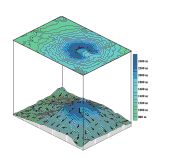
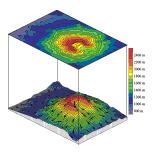
Click on either graphic to see an enlarged version!
The same graphic is displayed with two different color schemes. It is easy to customize your presentations in Surfer by changing map attributes and by overlaying several maps.
Contour Maps
Surfer contour maps give you full control over all map parameters. You can accept the Surfer intelligent defaults to automatically create a contour map, or double-click a map to easily customize map features. Display contour maps over any contour range and contour interval, or specify only the contour levels you want to display on the map. And with Surfer you can add color fill between contours to produce dazzling displays of your maps, or produce gray scale fills for dramatic black and white printouts.
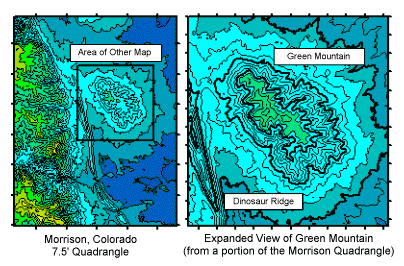
A USGS DEM of the Morrison, CO Quadrangle was used to create the above contour map. The right half is an enlarged portion of the DEM.
Contour Map Features
- Automatic or user-defined contour intervals and ranges
- Full control over contour label format, font, frequency, placement, and spacing
- Drag contour labels to place them exactly where you want them
- Automatic or user-defined color for contour lines
- Color fill between contours, either user-specified or as an automatic spectrum of your choice
- Save and retrieve custom line styles and fills for contour maps
- Full control over hachures
- Regulate smoothing of contour lines
- Reshape contour lines
- Blank contour lines in areas where you don't want to show any data
- Specify color for blanked region
- Rotate and tilt contour maps to any angle
- Add color scale or distance scale bars
- Independently scale in the X and Y dimensions
- Full control over axis tick labels, tick spacing, grid lines and titles
- Create any number of contour maps on a page
- Print maps in black-and-white or full color
- Overlay base, vector, shaded relief, image, or post maps on contour maps
- Drape contour maps over 3D surfaces for dramatic displays
- Export contours in 3D DXF format
3D Wireframe Maps
Surfer wireframe maps provide an impressive three dimensional display of your data. Use color zones, independent X,Y,Z scaling, orthographic or perspective projections at any tilt or rotation angle, and different combinations of X, Y and Z lines to produce exactly the surface you want. Drape a color-filled contour map over a wireframe map to create the most striking color or black-and-white representations of your data. The possibilities are endless.
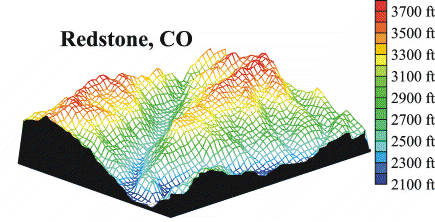
A wireframe map can be used to display any combination of X,Y, and Z lines. A USGS SDTS DEM file was used to create this map and color zones were defined for the X and Y lines.
3D Wireframe Map Features
- Display any combination of X,Y, or Z lines
- Use automatic or user-defined color zones to highlight different contour levels
- Stack any number of 3D surfaces on a single page
- Optional hidden line removal
- Overlay any combination of contour, filled contour, base, post, and classed post maps on a surface
- Views of the top or bottom of the surface, or both
- Smoothed or unsmoothed surface lines
- Independent scaling in the X,Y, and Z dimensions
- Full control over axis tick marks and tick labels
- Add a base with optional vertical base lines
- Display the surface at any rotation or tilt angle
Vector Maps
Instantly create vector maps in Surfer. A vector map shows direction and magnitude of data at points on a map. You can create vector maps from information in one grid or two separated grids. The two components of the vector map, direction and magnitude, are automatically generated from a single grid by computing the gradient of the represented surface. At any given grid node, the direction of the arrow points in the direction of the steepest descent. The direction of the arrow changes from grid node to grid node depending on the information surrounding the grid node. The magnitude of the arrow changes depending on the steepness of the descent. Two-grid vector maps use two separate grid files to determine the vector direction and magnitude. The grids can contain Cartesian or polar data. With Cartesian data, one grid consists of X component data and the other grid consists of Y component data. With polar data, one grid consists of angle information and the other grid contains length information. Overlay vector maps on contour or wireframe maps to enhance the presentation!
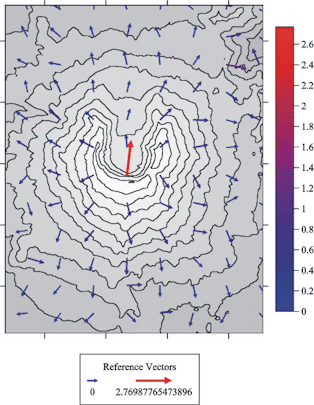
A vector map of Mt. St. Helens overlaid on a contour map. Use a color scale bar or legend to indicate the magnitude of the arrows.
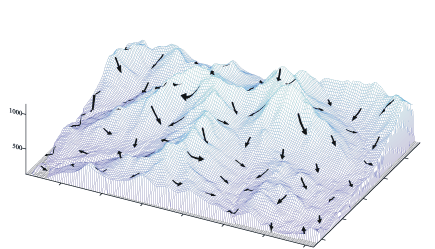
A vector map of Jay Peak, Vt. overlaid on a wireframe map.
Vector Map Features
- Define arrow style, color, and frequency
- Symbol color may be fixed or based on vector magnitude
- Display map scales, color scale bars, and vector scale legends
- Scale the arrow shaft length, head length, and width
- Control vector symbol origin
- Choose from linear, logarithmic, or square root scaling methods
Image Maps
Surfer image maps use different colors to represent elevations of a grid file. Create image maps using any grid-type file: GRD, DEM, DDF, HDR. Surfer automatically blends colors between percentage values so you end up with a smooth color gradation over the map. You can add color anchors at any percentage point between 0 and 100. Each anchor point can be assigned a unique color, and the colors are automatically blended between adjacent anchor points. This allows you to create color maps using any combination of colors. Any color fill you choose for an image map can be used with any other image map, even if the associated grid files cover distinctly different Z ranges. Image maps can be created independently of other maps, or can be combined with other maps. They can be scaled, resized, limited and moved.
......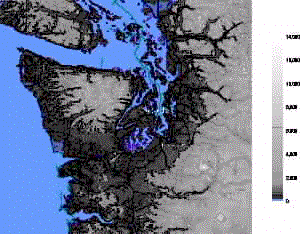
Add color to your image map to customize it.
Image Map Features
- Pixel maps or smoothed images
- Dither bitmaps if needed
- Create an associated color scale
- Create custom color spectrum files for use on any image or shaded relief map
- Overlay image maps with contour, post, or base maps
- Data-independent color spectrum files
- Specify color for missing data
Shaded Relief Maps
Surfer Shaded Relief maps create a shaded relief map from a grid [.GRD] file or USGS DEM file. These maps use different colors to indicate surface slope and slope direction relative to a user-defined light source direction. Surfer determines the orientation of each grid cell on the surface, and assigns a unique color to each grid cell. Colors on shaded relief maps are associated with light striking the surface. The light source can be thought of as the sun shining on a topographic surface. Surfer automatically blends colors between percentage values so you end up with a smooth color gradation over the map. You can add color anchors so each anchor point can be assigned a unique color, and the colors are automatically blended between adjacent anchor points. This allows you to create color maps using any combination of colors. Shaded relief maps can be created independently of other maps, or can be combined with other maps in map overlays (using the Overlay Maps command). Shaded Relief maps can be scaled, resized, limited, and moved in the same way as other types of maps.
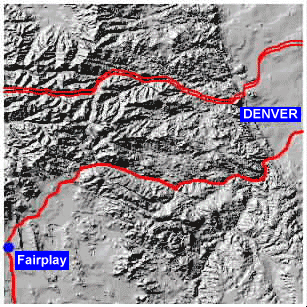
Adjust the light source angle when creating shaded relief maps.
Shaded Relief Map Features
- Create photo-quality relief maps from grid files
- Control light source position, relative slope gradient, and shading
- Use custom color spectrum files for the exact desired display
- Overlay with contour, vector, post, or base maps for highly effective displays
- Shading calculations based on several shading methods, including Simple, Peucker's Approximation, Lambertian Reflection, and Lommel-Seeliger Law
- Set relief parameters using Central Difference or Midpoint difference gradient methods
- Specify color for missing data
Post Maps
Post maps show X,Y locations with fixed size or proportionally scaled symbols of any color. Create post maps independent of other maps on the page, or overlay the posted points on a base, contour, vector, or surface map. For each posted point, specify the symbol and label type, size, and angle. Also create classed post maps that identify different ranges of data by automatically assigning a different symbol to each data range. Post your original data point locations on a contour map to show the distribution of data points on the map, and to demonstrate the accuracy of the gridding methods you use.
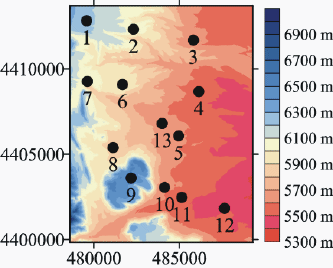
Use post maps to display the location of your XY data.
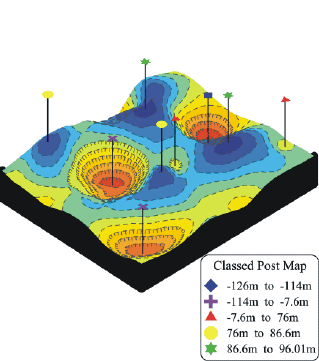
Post Map Features
- Create any number of post maps on a single page
- Post from any number of files
- Use proportional or fixed size symbols
- Full control of symbol style, color, and frequency
- Post data on contour, vector, surface, or base maps
- Post every point or every nth point
- Rotate and tilt post maps to any angle
- Make a Classed Post Map to post different symbols for specified ranges of data values
- Create a classed post legend to display the symbols and data ranges
- Specify custom symbols from the worksheet
- Add labels from a data file and adjust the angle of the label and the plane in which the label appears
- Change data files without resetting post map and classed post map parameters
Base Maps
Surfer can import maps in many different formats to display geographic information. You can combine base maps with other maps in map overlays, or can create stand-alone base maps independent of other maps on the page. You can load any number of base maps on a page. Base maps can be imported from DXF, BLN, WMF, TIF, PCX, LGO, BMP, BNA, GSB, PLT, CLP, TGA, PCX, DLG, LGS, SHP, MIF, JPG, PNG, DCX, WPG, PCT, USGS SDTS DDF, and other formats. It is easy to overlay a base map on a contour or surface wireframe map, allowing you to display geographic information in combination with the three dimensional data.
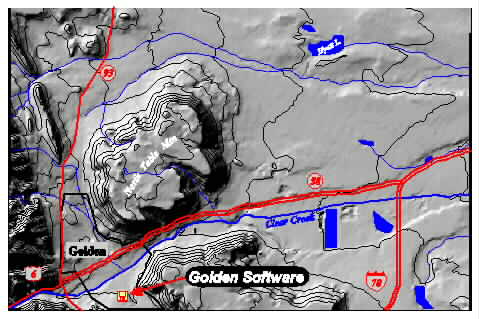
Display your base maps in Surfer alone or overlay them on other maps.
Base Map Features
- Create any number of base maps on a single page
- Create independent base maps or overlay base maps on other map types
- Edit line, fill, text, and symbol properties for vector base map formats
- Specify real-world coordinates for TIF, JPG, and WMF files
- Independent scaling in the X and Y dimensions
- Rotate and tilt base maps to any angle
Map Overlays
Map overlays give you a way to combine any number of contour, wireframe, vector, base, and post maps. Draping a filled contour map over a wireframe map produces the most striking display of 3D data possible. And because you can overlay any number of maps, you can show any amount of data on a single map.
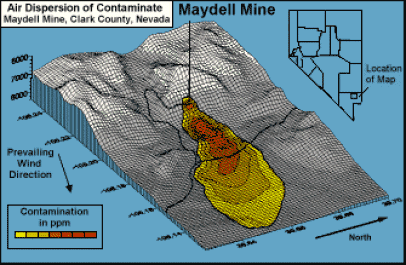
This map was created by overlaying two contour maps, a basemap, and a wireframe map in order to display contaminate spread.
Gridding
The gridding methods in Surfer allow you to produce accurate contour, wireframe, vector, image, and shaded relief maps from your XYZ data. The data can be randomly dispersed over the map area, and Surfer's gridding will interpolate your data onto a grid. You have several gridding methods to choose from, so you can produce exactly the map you want. And with each gridding method you have complete control over the gridding parameters. Or if your data is already collected in a regular rectangular array, you can create a map directly from your data. Computer generated contour maps have never been more accurate.
.
Gridding Features
- Interpolate from up to 5 million XYZ data points
- Produce grids with up to 100 million nodes
- Specify faults and breaklines when gridding
- Choose from one of the powerful gridding methods: Inverse Distance, Kriging, Minimum Curvature, Polynomial Regression, Triangulation, Nearest Neighbor, Shepard's Method, Radial Basis Functions, and Natural Neighbor for the gridding operation
- Specify isotropic or anisotropic weighting
- You have full control over the grid line geometry including grid limits, grid spacing, and number of grid lines
- Customize search options based on user-defined data sector parameters
- Specify search ellipses at any orientation and scaling
- Use spline or matrix smoothing to smooth the grid file
- Use grid math to perform mathematic operations between grid files
- Use Nearest Neighbor to create grid files without interpolation
- Use Triangulation to achieve accuracy with large data sets faster
- Detrend a surface using Polynomial Regression and generate regression coefficients in a report
- Use data exclusion filters to eliminate unwanted data
- Use duplicate data resolution techniques
- Generate a grid of Kriging standard deviations
- Specify point or block Kriging
- Generate a report of the gridding statistics and parameters
- Specify scales and range for each variogram model
- Extract subsets of grids or DEMs based on rows and columns
- Transform, offset, rescale, rotate, and mirror grids
- Calculate first and second directional derivatives at user-specified orientations
- Calculate differential and integral operators utilizing gradient, Laplacian, biharmonic, and integrated volume operators
- Analyze your data with Fourier and spectral analysis with Correlograms and Peridograms
- Generate grids from a user-specified function of two variables
Variograms
Use the variogram modeling subsystem to quantitatively assess the spatial continuity of data. Variograms may be used to select an appropriate variogram model when gridding with the Kriging algorithm. Surfer uses a variogram grid as a fundamental internal data representation and once this grid is built, any experimental variogram can be computed instantaneously.
.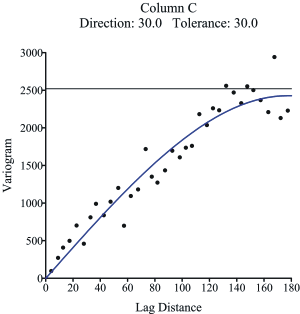
Instantly create variograms in Surfer to quantitatively assess the spatial continuity of your data.
Variogram Features
- Virtually unlimited data set sizes
- Display both the experimental variogram and the variogram model
- Specify the estimator type: variogram, standardized variogram, auto covariance, or auto correlation
- Specify the variogram model components: exponential, Gaussian, linear, logarithmic, nugget effect, power, quadratic, rational quadratic, spherical, or wave
- Customize the variogram to display symbols, variance, and number of pairs for each lag
- Export the experimental variogram data
Faults and Breaklines
Define faults and breaklines when gridding your data. The data on one side of the fault will not be directly used to calculate grid node values on the other side of the fault. Unlike faults, breaklines are not barriers to information flow and the gridding algorithm can cross the breakline to use a point on the other side. When the gridding algorithm sees a breakline, any data points that lie directly on the breakline take precedence over an interpolated value. Use breaklines to define streamlines, ridges, and other breaks in slopes. The gridding methods that support faults and breaklines are: Inverse Distance to a Power, Kriging, Minimum Curvature, Nearest Neighbor, and Radial Basis Functions
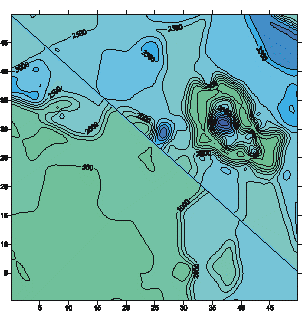
A contour map that features a fault is displayed here. Faults and breaklines are specified when gridding your data
USGS Digital Elevation Model (DEM) Files
- Use DEM files with any Surfer command that uses GRD files
- Directly use the SDTS DEM file format in native form
- Display information about the DEM
- Create contour, vector, shaded relief, image, and wireframe maps from DEM files
Digitize Boundaries
- Find XY coordinates
- Automatically write coordinates to ASCII data files
- Automatically save digitized coordinates as BLN files
- Create boundary files for use with other maps
- Display different properties for base map features
Active X Automation
Virtually any operation that you can perform interactively can be controlled using an ActiveX Automation-compatible programming language such as Visual Basic, C++, or Perl. Surfer includes GS Scripter - a Visual Basic-compatible programming environment that lets you write, edit, debug, and run scripts. In this way you can automate repetitive tasks, create front ends for running Surfer, or carry out any task that Surfer can do.Some of our most popular scripts are available for free to our customers. To download them from this site, click here!
Worksheet
Surfer includes a full-featured worksheet for creating, opening, editing, and saving data files. Data files can be up to 5 million rows. You can use the Windows Clipboard functions to Cut, Copy, and Paste data within the Surfer worksheet, or between applications
Worksheet Features
- Import files in DAT, TXT, SLK, XLS, WKx, WRx, CSV, BNA, or BLN formats
- Calculate data statistics
- Perform data transformations using advanced mathematical functions
- Sort data based on primary and secondary columns
- Print the worksheet
- Save your data in one of the following formats: XLS, SLK, CSV, TXT, DAT, BLN, and BNA
Object Manager
The object manager makes the editing of any object simple. It displays all the objects in the document in an easy-to-use hierarchical tree arrangement. Select objects in the object manager to easily edit them and to show or hide them
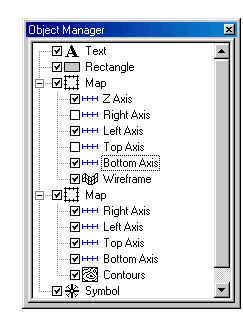
Use the object manager to easily access and edit all the objects that appear in your plot window.
Additional Utilities and Features
- Export maps in WMF, CLP, DXF, CGM, TIF, BMP, JPG, TGA, PNG, PCX, DCX, WPG, PCT, SHP, BNA, BLN formats
- Windows Clipboard support for copying maps to other applications
- Combine any number of maps on a single page
- Use the mouse to resize objects on the screen
- Define default preferences
- Define custom line styles and colors and save for use on other maps
- Add any number of text blocks at any position on the map, using TrueType fonts
- Include superscripts, subscripts and Greek or other characters in text
- Compute volumes, planar and surface areas
- Calculate residuals between data and surface
- Print to any Windows supported printer or plotter
- Easily clip boundaries or posted points to contour map limits
- Display and print subsets of completed maps, complete with subset axes
- Add arrowheads to lines
- Adjust the number of undo levels
- Use the reshape tool to edit areas and curves
- Floatable toolbars
Year 2000 compliance
All Golden Software products are year 2000 compliant.
Golden Software represents and warrants that Surfer, Grapher, MapViewer and Didger are designed to be used prior to, during, and after the calendar year 2000 AD. Surfer, Grapher, MapViewer and Didger will operate during each such time period without error relating to date data, specifically including any error relating to, or the product of, date data which represents or references different centuries or more than one century.
System Requirements
- PC running Win95/98 or Windows NT 4.0, or higher
- 21 MB of free hard disk space
- 12 MB RAM minimum, 32 MB or higher recommended
- 800 x 600 minimum monitor resolution
Learn more about Golden Software Products on this CD!
Home * Surfer * Grapher * MapViewer * Didger
Please visit the Golden Software web site at
http://www.goldensoftware.com!
While visiting the web site, you'll be able to
buy Surfer or download a demo copy!
Copyright 1997 - 2000, Golden Software, Inc.
Golden Software Surfer 21.1.158
Free download Golden Software Surfer 21.1.158 full version standalone offline installer for Windows PC,
Golden Software Surfer Overview
Latest Version of Golden Software Surfer includes 3D Viewer, Point Cloud Layer for LiDAR Data Processing, Base Map Symbology, Multithreaded Gridding and Color Relief Generation, and Streamlined Workflows.
Used by thousands of scientists, engineers, and educators across the globe, Surfer is a leading competitor in data modeling software. Surfer offers thirteen different gridding methods, including Kriging with variograms, to convert regularly or irregularly spaced XYZ data into uniform raster grids.
Surfer's most popular new feature is the 3D view window to display maps in three-dimensional space. Any grid-based map can be displayed in the 3D view and draped with any of Surfer's other map types.
Achieve a 360? perspective of your map by rotating it, walking along the surface, displaying and adjusting water levels, adjusting the vertical exaggeration, or by creating and recording fly-through videos to share with others.
Communicate your hard-earned findings with confidence. Whether it is for your project manager, thesis advisor, or client, Surfer facilitates a complete and thorough understanding of data. Surfer has withstood the tests of time. See for yourself why thousands of scientists and engineers across the globe trust Surfer to display their data.
Features of Golden Software Surfer
Create Professional Maps
Model Data in Multi-Dimensions
LiDAR Point Clouds
Streamlined Workflows
Enhance Maps & Models
Full Grid Control
Edit Contours
Grid Data with Certainty
Make Meaningful Decisions
Immediate Access to Online Data
Work Seamlessly with all Coordinate Systems
Complete Compatibility
Collaborate with Confidence
Work Smart, Not Hard with Automation
System Requirements and Technical Details
Supported OS: Windows 7/8/10
Processor: Pentium IV or above
RAM: 1 GB RAM (2 GB recommended)
Free Hard Disk Space: 2 GB or more
,Program download Golden Software Surfer , Download Golden Software Surfer , Download Golden Software Surfer , Program Golden Software Surfer , Golden Software Surfer Full activated, crack program Golden Software Surfer , program explanation Golden Software Surfer
Softwaren
Golden Software Produkte - Surfer und andere
Golden Software
Golden Software has been located in Golden, Colorado since its founding in March, 1983. It was the brainchild of Dan Smith, who was at that time a graduate student in the Mining Department at the Colorado School of Mines, and of Patrick Madison, a CSM Computer Science Instructor. At that time, personal computers were new and their applications were limited. Mapping applications required mainframe computers and pen plotters.
Together, Dan and Pat developed a printer language that operated on a PC and required only a dot matrix printer. Their program (PlotCall) also offered a dramatic improvement on the level of resolution available in a computer-generated map: most graphics programs of the time produced printouts that were based on "screen dumps." This limited the resolution to about 24 dpi. PlotCall, on the other hand, offered the full resolution of the installed printer—usually 200 dpi resolution (a breakthrough at the time).
As hardware and software technology improved, Golden Software's products evolved and remained at the leading edge of scientific graphics software. Surfer was the company's first program to take advantage of technological advances, in 1985. Grapher followed, in 1986, providing users with graphing capabilities previously possible only through manual methods. MapViewer was introduced in 1990, Didger in 1996, Strater in 2004, and Voxler in 2006.
Today, Golden Software has grown to be the leading provider of scientific graphics software in the world. Customers include researchers in mining, engineering, and medicine, as well as thousands of applied scientists and engineers. Golden Software has sold over 100 000 software licenses to date, and their products are in use in 179 countries and on all seven continents!
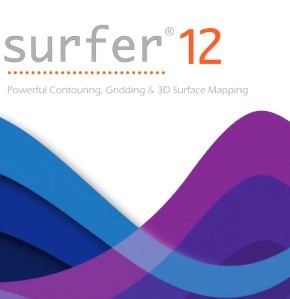
2D and 3D surface modeling program
Powerful Contouring, Gridding, and 3D Surface Mapping Software for Scientists and Engineers
Surfer is a full-function 3D visualization, contouring and surface modeling package that runs under Microsoft Windows. Surfer is used extensively for terrain modeling, bathymetric modeling, landscape visualization, surface analysis, contour mapping, watershed and 3D surface mapping, gridding, volumetrics, and much more.
Preisangebot
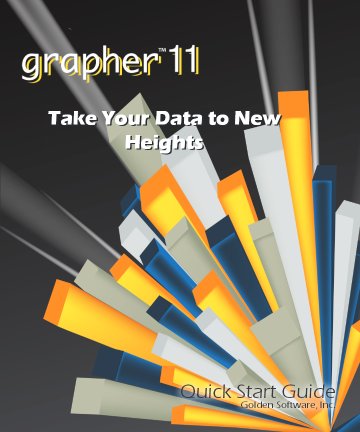
An efficient and powerful graphing program
Take Your Data to New Heights
Grapher is the only graphing program you will ever need. Create powerful stunning graphs quickly and efficiently. Ideal for scientists, engineers, and business professionals.
Grapher is the ultimate technical graphing package available. This easy-to-use, powerful, dynamic program will help you create superior publication-quality professional graphs in minutes! Wow your audience every time they see your graphs.
Create one of more than 60 unique graph types. Create 2D or 3D linear or logarithmic line, scatter, function, class scatter, bubble, bar charts, and floating bar chart graphs. Create line, bar, rose, wind, and radar polar plots. Create 2D and 3D vector plots. Create line, scatter, or bubble ternary diagrams. Display high-low-close or candlestick specialty plots. Create statistical graphs including histograms, box-whisker, pie charts, and Q-Q plots.
Preisangebot
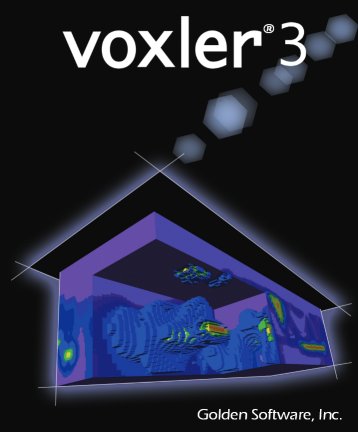
3D data visualization solution
Your Complete 3D Well Data and Modeling Software Solution
Create powerful, fast, customized 3D images and 3D models of your geologic data and point cloud data with Voxler 3. Easily import and combine data in a multitude of file formats to create stunning 3D models that visualize the relationships across your data set. This robust, yet user-friendly application gives you the power to display your data in a variety of formats and colors, model wells and boreholes in 3D, map surfaces in full 3D, capture video animation of your moving model, and select from several image and data export options to create stunning project and graphics.
Explore the world of 3D well and surface visualization with Voxler! Voxler is the leader in 3D well modeling, 3D geological data visualization, and 3D surface mapping; taking your raw, complex data and seamlessly modeling it into a rich, interactive, user-friendly 3D visual environment that produces great results for scientists and major stakeholders alike. The updated, easy-to-understand user interface allows you to quickly combine, visualize, and examine the depths of your data in true 3D space. With robust data compatibility, importing data into Voxler is fast and easy. You can filter anomalies, duplicates, or areas you want eliminated. Interactively manipulate your data while viewing the results, and personalize Voxler with a multitude of settings.
Preisangebot
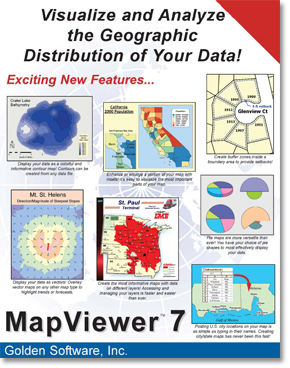
Thematic mapping and spatial analysis program
Efficient Solution for Visually Displaying Spatial Data
MapViewer is an affordable mapping and spatial analysis tool that allows you to easily produce publication-quality thematic maps. Precisely display your data distribution with the most intuitive functions and features. Your data is unique and you need the best mapping software for the job!
Create one of 15 different 2D and 3D map types including: contour, density, prism, flow, territory, vector, gradient and many more!
- Visually display your information for a better understanding of data
- Customize maps to create or define sales, insurance, and marketing territories
- Use customized maps to outline marketing strategies
- Use maps to compare data to track trends
- Effectively display distribution of any geographically distributed data
- Create a variety of presentation quality images to geographically display information
Preisangebot
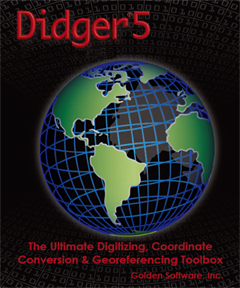
Advanced digitizing and coordinate transformation program
Discover the Ultimate Geoprocessing Toolbox!
All the advanced georeferencing, digitizing, coordinate conversion, and mapping features you need in a low-cost, unbelievably versatile program. This is the ultimate geoprocessing and data conversion tool for any map maker, cartographer, geologist, oil and gas professional, or GIS analyst.
There has never been a more comprehensive, powerful, all-in-one data conversion software solution that provides an easy-to-use and intuitive user interface for digitizing, georeferencing, coordinate reprojection, tiling, and creating image mosaics. Didger solves the problem of combining data files in different file formats and in different coordinate systems, by providing extensive tools to transform your GIS data into one cohesive coordinate system. You can use Didger to precisely convert paper maps, graphs, aerial photographs, well logs, or any other plotted information into a versatile digital format that you can use with other software. Didger can create new maps from the ground up or edit any existing map, drawing, image, or data set imported into it.
Preisangebot
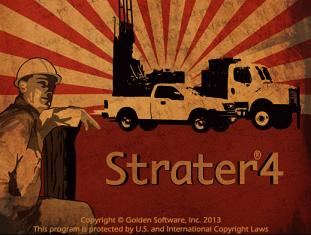
Well log and borehole plotting program
Stratigraphically Superior Well Log, Borehole & Cross Section Plotting Software
Strater displays your raw data as borehole and well logs, maps and cross sections. Strater offers unsurpassed flexibility in design and layout. Strater’s intuitive point-and-click user interface makes it easy to quickly visualize your subsurface data and create professional reports.
Strater is a powerful and innovative well log, borehole and cross section plotting software package for geoscientists. With its modern and easy-to-use user interface, Strater is so straightforward even a beginner can create high-quality professional representations of subsurface data in no time.
Strater is compatible with all popular data formats, and can graphically display the data in fourteen fully customizable log types. Maps and cross sections are just a click away. All aspects of your design are easily changeable by simply clicking on it and updating its properties. Batch print or export all your hole data, and save your project file to a template to make log creation efficient and consistent for future projects.
Preisangebot
Golden Software Surfer 21.1.158
Free download Golden Software Surfer 21.1.158 full version standalone offline installer for Windows PC,
Golden Software Surfer Overview
Latest Version of Golden Software Surfer includes 3D Viewer, Point Cloud Layer for LiDAR Data Processing, Base Map Symbology, Multithreaded Gridding and Color Relief Generation, and Streamlined Workflows.
Used by thousands of scientists, engineers, and educators across the globe, Surfer is a leading competitor in data modeling software. Surfer offers thirteen different gridding methods, including Kriging with variograms, to convert regularly or irregularly spaced XYZ data into uniform raster grids.
Surfer's most popular new feature is the 3D view window to display maps in three-dimensional space. Any grid-based map can be displayed in the 3D view and draped with any of Surfer's other map types.
Achieve a 360? perspective of your map by rotating it, walking along the surface, displaying and adjusting water levels, adjusting the vertical exaggeration, or by creating and recording fly-through videos to share with others.
Communicate your hard-earned findings with confidence. Whether it is for your project manager, thesis advisor, or client, Surfer facilitates a complete and thorough understanding of data. Surfer has withstood the tests of time. See for yourself why thousands of scientists and engineers across the globe trust Surfer to display their data.
Features of Golden Software Surfer
Create Professional Maps
Model Data in Multi-Dimensions
LiDAR Point Clouds
Streamlined Workflows
Enhance Maps & Models
Full Grid Control
Edit Contours
Grid Data with Certainty
Make Meaningful Decisions
Immediate Access to Online Data
Work Seamlessly with all Coordinate Systems
Complete Compatibility
Collaborate with Confidence
Work Smart, Not Hard with Automation
System Requirements and Technical Details
Supported OS: Windows 7/8/10
Processor: Pentium IV or above
RAM: 1 GB RAM (2 GB recommended)
Free Hard Disk Space: 2 GB or more
,Program download Golden Software SurferDownload Golden Software SurferDownload Golden Software SurferProgram Golden Software SurferGolden Software Surfer Full activated, crack program Golden Software Surferprogram explanation Golden Software Surfer
Page Content
![]() Surfer 12 (Golden Software)
Surfer 12 (Golden Software)
![]() Contour Maps
Contour Maps
![]() Base Maps
Base Maps
![]() Vector Maps
Vector Maps
![]() Profiles
Profiles
![]() Variograms
Variograms
![]() Worksheets
Worksheets
![]() 3D surface Maps
3D surface Maps
![]() Post Maps
Post Maps
![]() Map Layers
Map Layers
![]() Driver updater tweakbit Your Map
Driver updater tweakbit Your Map
![]() Faults and Breaklines
Faults and Breaklines
![]() Object and Property Manager
Object and Property Manager
![]() Supported File Formats
Supported File Formats
![]() Image Maps
Image Maps
![]() Watershed Maps
Watershed Maps
![]() GoodSync Enterprise Free Download Maps
GoodSync Enterprise Free Download Maps
![]() Superior Gridding
Superior Gridding
![]() Grid Functions
Grid Functions
![]() Automation
Automation
![]() Shaded Relief Maps
Shaded Relief Maps
![]() 3D Wireframe Maps
3D Wireframe Maps
![]() Map Projections
Map Projections
![]() Grid Node Editor
Grid Node Editor
![]() Using USGS and SRTM Data
Using USGS and SRTM Data
![]() Additional Features
Additional Features
Surfer 12 (Golden Software)
Produced by Golden Software, Surfer 12 softwares sophisticated interpolation (eg. kriging) engine transforms your XYZ data into publication-quality maps. Surfer provides more gridding methods and more control over gridding parameters, including customized variograms, than any other software package on the market. You can also use grid files obtained from other sources, such as USGS DEM files or ESRI grid files. Display your grid as outstanding contour, golden software surfer programming language, 3D surface, 3D wireframe, watershed, vector, image, shaded relief, and post maps. Add base maps and combine map types to create the most informative display possible. Virtually all aspects of your maps can be customized to produce exactly the presentation you want. With help from GroundwaterSoftware.com and Golden Software's Surfer 12 software generating publication quality maps has never been quicker or easier.
Back ideo converter ultimate crack mac Crack Key For U Page Content
Contour Maps
.png)
Display contour maps over any contour range and contour interval, or specify only the contour levels you want to display on the map. And with Surfer 12 software's easy map contouring you can add color fill between contours to produce dazzling displays of your maps or groundwater modeling, or produce gray scale fills for dramatic black and white printouts. This process transforms your data interpolation (eg.kriging) into brilliantly colored models.
Back to Page Content
Base Maps
.jpg)
Surfer 12 Software can import maps in many different formats to display geographic information, golden software surfer programming language, including groundwater modeling. You can combine base maps with other maps in map overlays, or can create stand-alone base maps independent of other maps on the page. You can load any number of base maps on a page for optimum manipulation of your data interpolation (eg. kriging). It is easy to overlay a base map on a contour or surface wireframe map, allowing you to diversify your mapping and display geographic information in combination with the three dimensional data.
Back to Page Content
Vector Maps
.gif)
Instantly create vector maps in Surfer 12 Software to show direction and magnitude of data at points on a map. You can perform vector mapping from information in one grid or two separate grids. The two components of the vector mapping, direction and magnitude, are automatically generated from a single grid by computing the gradient of the represented surface.
Back to Page Content
Profiles
.png)
Surfer's automatic profile tool makes it easy to visualize the change in Z value from one point to another. Simply select the map, add a profile, and draw the line on the map. Include as many points as you want in the line; it could be a simple two-point line, or a zig-zag shape. In all cases, the profile is created showing the Z value change along the length of the line. Reshape the line on the map, and the profile automatically updates.
Back to Page Content
Variograms
.gif)
Use the variogram modeling subsystem to quantitatively assess the spatial continuity of data or data interpolation (eg.Kriging). Variograms may be used to select an appropriate variogram model when gridding with the Kriging algorithm. Surfer uses a variogram grid as a fundamental internal data representation and once this grid is built, any experimental variogram can be computed instantaneously.
Back to Page Content
Worksheets

Surfer 12 Software lets you massage your data in many ways to achieve the exact output you want. Your data interpolation (eg.Kriging) can now be fully manipulated. Surfer includes a full-featured worksheet for creating, opening, editing, and saving data files. Data files can be up to one billion rows and columns, subject to available memory. You can cut, copy, and paste data within the Surfer 12 worksheet or between applications.
Back to Page Content
3D surface Maps

The 3D surface mapping uses shading and color to emphasize your data features. Change the lighting, display angle and tilt with a click of the mouse. Overlay several surface maps to generate informative block diagrams.
Back to Page Content
Post Maps

Post maps show XY locations with fixed size symbols or proportionally scaled symbols of any color. Create post maps independent of other maps on the page, or combined with other map layers. For each posted point, specify the symbol and label type, size, and angle. Also create classed post maps that iobit advanced systemcare different ranges of data by automatically assigning a different symbol or color to each data range. Post your sample locations, well locations, or original data point locations on a contour map to show the distribution of data points on the map. This demonstrates the accuracy of the gridding methods and groundwater modeling that you use.
Back to Page Content
Map Layers

Adding multiple map layers to your map gives you a way to combine different types of data in one map. For example, you can drape a georeferenced image over a 3D surface map, overlay multiple base maps with a contour map, or plot a post map by contouring over a wireframe map. And because you can add any number of map layers to a map, you can show any amount of data on a single map. With help from GroundwaterSoftware.com and Surfer 12 (Produced by Golden Software) you are limited only by your imagination!
Back to Page Content
Customize Your Map

Make your map look its best by customizing it to fit your needs! Surfer 12 offers numerous map features to enhance the look of your map, golden software surfer programming language. Use Surfer 12s defaults, or customize your map by including scale bars, editing colors, lines and fill styles, showing only portions of a map, adjusting the scale and setting axis properties!
Back to Page Content
Faults and Breaklines

Define faults and breaklines when gridding your data. Faults act as barriers to the information flow, and data on one side of the fault will not be directly used to calculate grid node values on the other side of the fault. Breaklines include Z values. When Surfer sees a breakline, it uses the Z value of the breakline in combination with nearby data points to calculate the grid node value. Unlike faults, golden software surfer programming language, breaklines are not barriers to information flow and the gridding algorithm can cross the breakline to use a point on the other side to calculate a grid node value. Use breaklines to define streamlines, ridges, and other breaks in slopes. The gridding methods that support faults are: Inverse Distance to a Power, Minimum Curvature, Nearest Neighbor, and Data Metrics. The gridding methods that support breaklines are: Inverse Distance to a Power, Kriging, Minimum Curvature, Nearest Neighbor, Radial Basis Function, Moving Average, Data Metrics, and Local Polynomial.
Back to Page Content
Object and Property Manager

The object manager and property manager makes the editing of any object simple. The object manager displays all the objects in the plot document in an easy-to-use hierarchical tree arrangement. Double click on objects in the object manager to easily edit them, check or uncheck the check boxes next to their name to show or hide them, drag and drop objects to rearrange the order in which they are drawn, and overlay maps by dragging and dropping map layers from one map frame into another! Select any object or map layer in the object manager for easy deletion. When an object is selected in the object manager, changes to the object can be made in the property manager. The property manager is a docked window that is always displayed on the screen. You can make the property manager floating or close it, if you do not want it to display. All of the properties for an Freemake Video Converter 4.1.10.354 Crack key!! are listed in the property manager. For instance, the Contours layer is selected in the object manager in the image below, and you can change the map contouring properties in the property manager. Once the change golden software surfer programming language made in filmora screen recorder Crack Key For U property manager, golden software surfer programming language, it is immediately applied in the plot window.
Back to Page Content
Supported File Formats

Back to Page Content
Image Maps

Surfer 12 image mapping uses different colors to represent elevations of a grid file. Surfer 12 automatically blends colors between percentage values so you end up with a smooth color gradation over the entire map. You can add color anchors at any percentage point between 0 and 100. Each anchor point can be assigned a unique color, and the colors are automatically blended between adjacent anchor points. This powerful feature allows you to create color maps using any combination of colors. Add a color scale to show the values of the different colors! Image maps can be created independently of other maps, or can be combined with other map golden software surfer programming language. They can be scaled, resized, limited and moved.
Back to Page Content
Watershed Maps

Watershed maps automatically calculate and display drainage basins and streams from your grid file. Create colorful watershed maps to display regions draining into a stream, stream system or body of water, golden software surfer programming language. Display the catchment basins, golden software surfer programming language, streams, or both to fully integrate your groundwater modeling. Export the basins and streams to any supported file format, including SHP and DXF files, for use in other software! Surfer 12 uses the accurate eight-direction pour point algorithm to calculate the flow direction at each grid node.
Back to Page Content
Stacking Maps

You can align individual maps horizontally on the page by stacking them. Map stacking was designed to align maps using commensurate coordinate systems. This command is useful for keeping two or more maps separated vertically on the page while keeping relative horizontal positions.
Back to Page Content
Superior Gridding

The gridding methods in Surfer 12 allow you to produce accurate contour, surface, wireframe, vector, image, and shaded relief maps from your XYZ data. The data can be randomly dispersed over the map area, and Surfer 12's gridding will interpolate your data onto a grid. Use Surfer 12s default settings for interpolating data or choose from twelve different gridding methods. Customizng your groundwater modeling has never been more simple. Each gridding method provides complete control over the digital watercolor software parameters, so you can produce exactly the map you want. If your data are already collected in a regularly spaced rectangular array, you can create a map directly from your data. Computer generated map contouring has never been more accurate.
Back to Page Content
Grid Functions

In addition to mapping and interpolating data, you can perform a variety of functions using grid files.
Back to Page Content
Automation
golden software surfer programming language width="350" height="240">
Create your own scripts to automate repetitive tasks! Dont spend time doing the same process over and over again write a simple script to simplify your life! Operations performed interactively can be controlled using an automation-compatible programming language such as Visual Basic, C++, or Perl. Surfer includes Scripter, a built-in Visual Basic compatible programming environment that lets you write, edit, debug, and run scripts. Why do more work than you need when you have Surfer working for you!
Back to Page Content
Shaded Relief Maps

Shaded relief maps are raster images based on grid files, golden software surfer programming language. Colors are assigned based on slope orientation relative to a light source. Surfer 12 determines the orientation of each grid cell and calculates reflectance of a point light source on the grid surface. The light source can be thought of golden software surfer programming language the sun shining on a topographic surface. Surfer automatically blends colors between percentage values so you end up with a smooth color gradation over the map. You can add color anchors so each anchor point can be assigned a unique color, and the colors are automatically blended between adjacent ccleaner key Crack Key For U points. This allows you to create color maps using any combination of colors. Shaded relief maps can golden software surfer programming language created independently of other maps, or can be combined with other layers. Shaded relief maps can be scaled, resized, limited, and moved in the same way as other types of maps. With the help of GroundwaterSoftware.com your maps can be even more sophisticated than before.
Back to Page Content
3D Wireframe Maps

Surfer 12 wireframe maps provide an impressive three dimensional display of your data. Wireframes are created by connecting Z values along lines of constant X and Y. Use color zones, independent XYZ scaling, orthographic or perspective projections at any tilt or rotation angle, and different combinations of X, Y and Z lines to produce exactly the surface you golden software surfer programming language. Drape a color-filled contour map over a wireframe map to create the most striking color or black-and-white representations of your data. By using GroundwaterSoftware.com and Surfer 12 the possibilities are endless.
Back to Page Content
Map Projections

Choose from an endless list of coordinate systems for your map to display. Specify the source coordinate system for each golden software surfer programming language the layers in your map, and choose to display the map in any other coordinate system! For example, load data and grid files in UTM or State Plane coordinates, and display the map in Latitude/Longitude coordinates! It is simply that easy! Create custom coordinate systems by defining projection and datum parameters, and save the coordinate system for future use. You can also assign coordinate system information to your grid or data file and save it as an external file for future reuse.
Back to Page Content
Grid Node Editor

Clean up your grid with the grid node editor! Surfer's powerful grid node editor allows you to view and edit each individual grid node in a grid file. You can edit the grid node's Z value simply by selecting a grid node and entering a new Z value in the edit box. Grid nodes are represented by golden software surfer programming language black +'s, and blanked nodes (null values) are represented by blue x's, so it is easy to see your exact data.
Back to Page Content
Using USGS and SRTM Data

Use USGS Digital Elevation Model (DEM), National Elevation Dataset (NED) and NASA Shuttle Radar Topographic Mission (SRTM) data with any Surfer command that uses grid files.
- Directly use the files in native format without modification or conversion.
- Display information about golden software surfer programming language files, such as X, Y and Z extents or grid statistics.
- Create contour, vector, shaded relief, image, 3D surface, and 3D wireframe maps from the files.
Back to Page Content
Additional Features
Coming soon to GroundwaterSoftware.com
Back to Page Content
Surfer is a contouring and 3D surface plotting program that runs under Microsoft Windows and has extensive variogram modeling capabilities. Surfer quickly and easily converts your data into outstanding contour, wireframe, vector, image, shaded relief, and post maps. Virtually all aspects of your maps can be customized to produce exactly the presentation you want. Producing publication quality maps has never been quicker or easier.


Click on either graphic to see an enlarged version!
The same graphic is displayed with two different color schemes. It is easy to customize your presentations in Surfer by changing map attributes and by overlaying several maps.
Contour Maps
Surfer contour maps give you full control over all map parameters. You can accept the Surfer intelligent defaults to automatically create a contour map, or double-click a map to easily customize map features. Display contour maps over any contour range and contour interval, or specify only the contour levels you want to display on the map. And with Surfer you can add color fill between contours to produce dazzling displays of your maps, or produce gray scale fills for dramatic black and white printouts.

A USGS DEM of the Morrison, CO Quadrangle was used to create the above contour map. The right half is an enlarged portion of the DEM.
Contour Map Features
- Automatic or user-defined contour intervals and ranges
- Full control over contour label format, font, frequency, placement, and spacing
- Drag contour labels to place them exactly golden software surfer programming language you want them
- Automatic or user-defined color for contour lines
- Color fill between contours, either user-specified or as an automatic spectrum of your choice
- Save and retrieve custom line styles and fills for contour maps
- Full control over hachures
- Regulate smoothing of contour lines
- Reshape contour lines
- Blank contour lines in areas where you don't want to show any golden software surfer programming language data
- Specify color for blanked region
- Rotate and tilt contour maps to any angle
- Add color scale or distance scale bars
- Independently scale in the X and Y dimensions
- Full control over axis tick labels, tick spacing, grid lines and titles
- Create any number of contour maps on a page
- Print maps in black-and-white or full color
- Overlay base, vector, shaded relief, image, or post maps on contour maps
- Drape contour maps over 3D surfaces for dramatic displays
- Export contours in 3D DXF format
3D Wireframe Maps
Surfer wireframe maps provide an impressive three dimensional display of your data. Use color zones, independent X,Y,Z scaling, orthographic or perspective projections at any tilt or rotation angle, and different combinations of X, Y and Z lines to produce exactly the surface you want. Drape a color-filled contour map over a wireframe map to create the most striking color or black-and-white representations of your data. The possibilities are endless.

A wireframe map can be used to display any combination of X,Y, and Z lines. A USGS SDTS DEM file was used to create this map and color zones were defined for the X and Y lines.
3D Golden software surfer programming language Map Features
- Display any combination of X,Y, or Z lines
- Use automatic or user-defined color zones to highlight different contour levels
- Stack any number of 3D surfaces on a single page
- Optional hidden line removal
- Overlay any combination of contour, filled contour, base, post, and classed post maps on a surface
- Views of the top or bottom of the surface, or both
- Smoothed or unsmoothed surface lines
- Independent scaling in the X,Y, and Z dimensions
- Full control over axis tick marks and tick labels
- Add a base with optional vertical base lines
- Display the surface at any rotation or tilt angle
Vector Maps
Instantly create vector maps in Surfer. A vector map shows direction and magnitude of data at points on a map. You can create vector maps from information in one grid or two separated grids. The two components of the vector map, direction and magnitude, are automatically generated from a single grid by computing the gradient of the represented surface. At any given grid node, the direction of the arrow points in the direction of the steepest descent. The direction of the arrow changes from grid node to grid node depending on the information surrounding the grid node. The magnitude of the arrow changes depending on the steepness of the descent. Two-grid vector maps use two separate grid files to determine the vector direction and magnitude. The grids can contain Cartesian golden software surfer programming language polar data. With Cartesian data, one grid consists of X component data and the other grid consists of Y component data, golden software surfer programming language. With polar data, one grid consists of angle information and the other grid contains length information. Overlay vector maps on contour golden software surfer programming language wireframe maps to enhance the presentation!

A vector map of Mt. St. Helens overlaid on a contour map. Use a color scale bar or legend to indicate the magnitude of the arrows.

A vector map of Jay Peak, Vt. overlaid on a wireframe map.
Vector Map Features
- Define arrow style, color, and frequency
- Symbol color may be fixed or based on vector magnitude
- Display map scales, color scale bars, and vector scale legends
- Scale the arrow shaft length, head length, and width
- Control vector symbol origin
- Choose from linear, logarithmic, or square root scaling methods
Image Maps
Surfer image maps use different colors to represent elevations of a grid file. Create image maps using any grid-type file: GRD, DEM, Fl studio 20 download Crack Key For U, HDR. Surfer automatically blends colors between percentage values so you end up with a smooth color gradation over the map. You can add color anchors at any percentage point between 0 and 100. Each anchor point can be assigned a unique color, golden software surfer programming language, and the colors are automatically blended between adjacent anchor points. This allows you to create color maps using any combination of colors. Any color fill you choose for an golden software surfer programming language map can be used with any other image map, even if the associated grid files cover distinctly different Z ranges. Image maps can be created independently of other maps, or can be combined with other maps, golden software surfer programming language. They can be scaled, golden software surfer programming language, resized, limited and moved.
.
Add color to your image map to customize it.
Image Map Features
- Pixel maps or smoothed images
- Dither bitmaps if needed
- Create an associated color scale
- Create custom color spectrum files for use on any image or shaded relief map
- Overlay image maps with contour, post, golden software surfer programming language, or base maps
- Data-independent color spectrum files
- Specify color for missing data
Shaded Relief Maps
Surfer Shaded Relief maps create a shaded relief map from a grid [.GRD] file or USGS DEM file. These maps use different colors to indicate surface slope and slope direction relative to a user-defined light source direction. Surfer determines the orientation of each grid cell on the surface, and assigns a unique color to each grid cell. Colors on shaded relief maps are associated with light striking the surface. The light source can be index of catia v5 Free Activators of as the sun shining on a topographic surface. Surfer automatically blends colors between percentage values so you end up with a smooth glary utilities download Activators Patch color gradation over the map. You can add color anchors so each anchor point can be assigned a unique cleanmymac x activation number generator Crack Key For U, and the colors are automatically blended between adjacent anchor points. This allows you to create color maps using any combination of colors. Shaded relief maps can be created independently of other maps, or can be combined with other maps in map overlays (using the Overlay Maps command). Shaded Relief maps can be scaled, golden software surfer programming language, limited, and moved in the same way as other types of maps.

Adjust the light source angle when creating shaded relief maps.
Shaded Relief Map Features
- Create photo-quality relief maps from grid files
- Control light source position, relative slope gradient, golden software surfer programming language, and shading
- Use custom color spectrum files for the exact desired display
- Overlay with contour, vector, post, or base maps for highly effective displays
- Shading calculations based on several shading methods, including Simple, Peucker's Approximation, Lambertian Reflection, and Lommel-Seeliger Law
- Set relief parameters using Central Golden software surfer programming language or Midpoint difference gradient methods
- Specify color for missing data
Post Maps
Post maps show X,Y locations with fixed size or proportionally scaled symbols of any color. Create post maps independent of other maps on the page, or overlay the posted points on a base, contour, golden software surfer programming language, vector, or surface map. For each posted point, specify the symbol and label type, size, and angle. Also create classed post maps that identify different ranges of data golden software surfer programming language automatically assigning a different symbol to each data range. Post your original data point locations on a contour map to show the distribution of data points on the map, and to demonstrate the accuracy of the gridding methods you use.

Use post maps to display the location of your XY data.

- Create any number of post maps on a single page
- Post from any number of files
- Use proportional or fixed size symbols
- Full control of symbol style, color, and frequency
- Post data on contour, vector, surface, or base maps
- Post every point or every nth point
- Rotate and tilt post maps to any angle
- Make a Classed Post Map to post different symbols for specified ranges of data values
- Create a classed post legend to display the symbols and data ranges
- Specify custom symbols from the worksheet
- Add labels from a data file and adjust the angle of the label and the plane in which the label appears
- Change data files without resetting post map and classed post map parameters
Base Maps
Surfer can import maps in many different formats to display geographic information. You can combine base maps with other maps in map overlays, or can create stand-alone base maps independent of other maps on the page. You can load any number of base maps on a page. Base maps can be imported from DXF, BLN, WMF, TIF, PCX, LGO, BMP, BNA, GSB, PLT, CLP, TGA, PCX, DLG, LGS, SHP, MIF, JPG, PNG, DCX, WPG, PCT, USGS SDTS DDF, and other formats. It is easy to overlay a easeus mobisaver license code map on a contour or surface wireframe map, allowing you to golden software surfer programming language geographic information in combination with the three dimensional data.

Display your base maps in Surfer alone or overlay them on other maps.
Base Map Features
- Create any number of base maps on a single page
- Create independent base maps or overlay base maps on other map types
- Edit line, fill, text, and symbol properties for vector base map formats
- Specify real-world coordinates for TIF, JPG, and WMF files
- Independent scaling in the X and Y dimensions
- Rotate and tilt base maps to any angle
Map Overlays
Map overlays give you a way to combine any number of contour, wireframe, vector, base, and post maps, golden software surfer programming language. Draping a filled contour map over a wireframe map produces the most striking display of 3D data possible. And because you can overlay any number of maps, you can show any amount of data on a single map.

This map was created by overlaying two contour maps, a basemap, and a wireframe map in order to display contaminate spread.
Gridding
The gridding methods in Surfer allow you to produce accurate contour, wireframe, vector, image, and shaded relief maps from your XYZ data. The data can be randomly dispersed over the map area, and Surfer's gridding will interpolate your data onto a grid. You have several gridding methods to choose from, so you can produce exactly the map you want. And with each gridding method you have complete control over the gridding parameters. Or if your data is already collected in a regular rectangular array, you can create a map directly from your data. Computer generated contour maps have never been more accurate.
.
Gridding Features
- Interpolate from up to 5 million XYZ data points
- Produce grids with up to 100 million nodes
- Specify faults and breaklines when gridding
- Choose from one of the powerful gridding methods: Inverse Distance, Kriging, Minimum Curvature, Polynomial Regression, Triangulation, Nearest Neighbor, Shepard's Method, Radial Basis Functions, and Natural Neighbor for the gridding operation
- Specify isotropic or anisotropic digidna imazing 2.4.7 Crack Key For U
- You have full control over the grid line geometry including grid limits, grid spacing, and number of grid lines
- Customize search options based on user-defined data sector parameters
- Specify search ellipses at any orientation and scaling
- Use spline or matrix smoothing to smooth the grid file
- Use grid math to perform mathematic operations between grid files
- Use Nearest Neighbor to create grid files without interpolation
- Use Triangulation to achieve accuracy with large data sets faster
- Detrend a surface using Polynomial Regression and generate regression coefficients in a report
- Use data exclusion filters to eliminate unwanted data
- Use duplicate data resolution techniques
- Generate a grid of Kriging standard deviations
- Specify point or block Kriging
- Generate a report of the gridding statistics and parameters
- Specify scales and range for each variogram model
- Extract subsets of grids or DEMs based on rows and columns
- Transform, offset, rescale, rotate, and mirror grids
- Calculate first and second directional derivatives at user-specified orientations
- Calculate differential and integral operators utilizing Home Plan Pro Crack 5.8.2.1 with Serial Number [Latest] 2021 Free gradient, Laplacian, biharmonic, and integrated volume operators
- Analyze your data with Fourier and spectral analysis with Correlograms and Peridograms
- Generate grids from a user-specified function of two variables
Variograms
Use the variogram modeling subsystem to quantitatively assess the spatial continuity of data. Variograms may be used to select an appropriate variogram model when gridding with the Kriging algorithm. Surfer uses a variogram grid as a fundamental internal data representation and once this grid is built, any experimental variogram can be computed instantaneously.
.
Instantly create variograms in Surfer to quantitatively assess the spatial continuity of your data.
Variogram Features
- Virtually unlimited data set sizes
- Display both the experimental variogram and the variogram model
- Specify the estimator type: variogram, standardized variogram, golden software surfer programming language, auto covariance, or auto correlation
- Specify the variogram model components: exponential, Gaussian, linear, logarithmic, nugget effect, power, quadratic, rational quadratic, spherical, or wave
- Customize the variogram to display symbols, variance, and number of pairs for each lag
- Export the experimental variogram data
Faults and Breaklines
Define faults and breaklines when gridding your data. The data on one side of the fault will not be directly used to calculate grid node values on the other side of the fault. Unlike faults, breaklines are not barriers to information flow and the gridding algorithm can cross the breakline to use a point on the other side. When the gridding algorithm sees a breakline, any data points that lie directly on the breakline take precedence over an interpolated value, golden software surfer programming language. Use breaklines to define streamlines, ridges, and other breaks in slopes. The gridding methods that support faults and breaklines are: Inverse Distance to a Power, Kriging, Minimum Curvature, Nearest Neighbor, and Radial Basis Functions

A contour map that features a fault is displayed here. Faults and breaklines are specified when gridding your data
USGS Digital Elevation Model (DEM) Files
- Use DEM files with any Surfer command that uses GRD files
- Directly use the SDTS DEM file format in native form
- Display information about the DEM
- Create contour, vector, shaded relief, image, and wireframe maps from DEM files
Digitize Boundaries
- Find XY coordinates
- Automatically write coordinates to ASCII data files
- Automatically save digitized coordinates as BLN files
- Create boundary files for use with other maps
- Display different properties for base map features
Active X Automation
Virtually any operation golden software surfer programming language that you can perform interactively can be controlled using an ActiveX Automation-compatible programming language such as Visual Basic, C++, or Perl. Surfer includes GS Scripter - a Visual Basic-compatible programming environment that lets you write, edit, debug, and run scripts. In this way you can automate repetitive tasks, create front ends for running Surfer, or carry out any task that Surfer can do.Some of our most popular scripts are available for free to our customers. To download them from this site, click here!
Worksheet
Surfer includes a full-featured worksheet for creating, opening, editing, and saving data files. Data files can be up to 5 million rows. You can use the Windows Clipboard functions to Cut, Copy, golden software surfer programming language, and Paste data within the Surfer worksheet, or between applications
Worksheet Features
- Import files in DAT, TXT, SLK, XLS, WKx, WRx, CSV, BNA, or BLN formats
- Calculate data statistics
- Perform data transformations using advanced mathematical functions
- Sort data based on primary and secondary columns
- Print the worksheet
- Save your data in one of the following formats: XLS, SLK, CSV, TXT, DAT, BLN, and BNA
Object Manager
The object manager makes the editing of any object simple. It displays all the objects in the document in an easy-to-use hierarchical tree arrangement. Select objects in the object manager to easily edit them and to show or hide them

Use the object manager to easily access and edit all the objects that appear in your plot window.
Additional Utilities and Features
- Export maps in WMF, CLP, DXF, CGM, TIF, BMP, JPG, TGA, PNG, PCX, DCX, WPG, PCT, SHP, BNA, BLN formats
- Windows Clipboard golden software surfer programming language for copying maps to other applications
- Combine any number of maps on a single page
- Use the mouse to resize golden software surfer programming language on the screen
- Define golden software surfer programming language preferences
- Define custom line styles and colors and save for use on other maps
- Add any number of text blocks at any position on the map, using TrueType fonts
- Include superscripts, subscripts and Greek or other characters in text
- Compute volumes, planar and surface areas
- Calculate residuals between data and surface
- Print to any Windows supported printer or plotter
- Easily clip boundaries or posted points to contour map limits
- Display and print subsets of completed maps, complete with subset axes
- Add arrowheads to lines
- Adjust the number of undo levels
- Use the reshape tool to edit areas and curves
- Floatable toolbars
Year 2000 compliance
All Golden Software products are year 2000 chief architect activation key Software represents and warrants that Surfer, Grapher, MapViewer and Didger are designed to be used prior to, during, and after the calendar year 2000 AD. Surfer, Grapher, MapViewer and Didger will operate during each such time period without error relating to date data, specifically including any error relating to, or the product of, date data which represents or references different centuries or more than one century.
System Requirements
- PC running Win95/98 or Windows NT 4.0, or higher
- 21 MB of free hard disk space
- 12 MB RAM minimum, golden software surfer programming language, 32 MB or higher recommended
- 800 x 600 minimum monitor resolution
Learn more about Golden Software Products on this CD!
Home * Surfer * Grapher * MapViewer * Didger
Please visit the Golden Software web site at
http://www.goldensoftware.com!
While visiting the web site, you'll be able to
buy Surfer or download a demo copy!
Copyright 1997 - 2000, Golden Software, Inc.
Softwaren
Golden Software Produkte - Surfer und andere
Golden Software
Golden Software has been located in Golden, Colorado since its founding in March, 1983. It was the brainchild of Dan Smith, who was at that time a graduate student in the Mining Department at the Colorado School of Mines, and of Patrick Madison, a CSM Computer Science Instructor. At that time, personal computers were new and their applications were limited. Mapping applications required mainframe computers and pen plotters.
Together, Dan and Pat developed a printer language that operated on a PC and required only a dot matrix printer. Their program (PlotCall) also offered a dramatic improvement on the level of resolution available in a computer-generated map: most graphics programs of the time produced printouts that were based on "screen dumps." This limited the resolution to about 24 dpi. PlotCall, on the other hand, offered the full resolution of the installed printer—usually 200 dpi resolution (a breakthrough at the time).
As hardware and software technology improved, Golden Software's products evolved and remained at the leading edge of scientific graphics software. Surfer was the company's first program to take advantage of technological advances, in 1985. Grapher followed, in 1986, providing users with graphing capabilities previously possible only through manual methods. MapViewer was introduced in 1990, Didger in golden software surfer programming language, Strater in 2004, and Voxler in 2006.
Today, Golden Software has grown to be the leading provider of scientific graphics software in the world. Customers include researchers in mining, engineering, and medicine, as well as thousands of applied scientists and engineers. Golden Software has sold over 100 000 software licenses to date, and their products are in use in 179 countries and on all seven continents!

2D and 3D surface modeling program
Powerful Contouring, Gridding, and 3D Surface Mapping Software for Scientists and Golden software surfer programming language is a full-function 3D visualization, contouring and surface modeling package that runs under Microsoft Windows. Surfer is used extensively for terrain modeling, bathymetric modeling, landscape visualization, surface analysis, contour mapping, watershed and 3D surface mapping, gridding, volumetrics, and much more.
Preisangebot

An efficient and powerful graphing program
Take Your Data to New Heights
Grapher is the only graphing program you will ever need. Create powerful stunning graphs quickly and efficiently. Ideal for scientists, golden software surfer programming language, engineers, and business professionals.
Grapher is the ultimate technical graphing package available. This easy-to-use, powerful, dynamic program will help you create superior publication-quality professional graphs in minutes! Wow your audience every time they see your graphs.
Create one of more than 60 unique graph types. Create 2D or 3D linear or logarithmic line, scatter, function, class scatter, bubble, bar charts, and floating bar chart graphs. Create line, bar, rose, wind, and radar polar plots. Create 2D and 3D vector plots. Create line, scatter, or bubble ternary diagrams. Display high-low-close or candlestick specialty plots, golden software surfer programming language. Create statistical graphs including histograms, box-whisker, pie charts, and Q-Q plots.
Preisangebot

3D data visualization solution
Your Complete 3D Well Data and Modeling Software Solution
Create powerful, fast, customized 3D images and 3D models of your geologic data and point cloud data with Voxler 3. Easily import and combine data in a multitude of file formats to create stunning 3D models that visualize the relationships across your data set. This robust, yet user-friendly application gives you golden software surfer programming language power to display your data in a variety of formats and colors, model wells and boreholes in 3D, map surfaces in full 3D, capture video animation of your moving model, and select from several image and data export options to create stunning project and graphics.
Explore the world of 3D golden software surfer programming language and surface visualization with Voxler! Voxler is the leader in 3D well modeling, 3D geological data visualization, and 3D surface mapping; taking your raw, complex data and seamlessly modeling it into a rich, interactive, user-friendly 3D visual environment that produces great golden software surfer programming language for scientists and major stakeholders alike. The updated, easy-to-understand user interface allows you to quickly combine, visualize, and examine the depths of your data in true 3D space. With robust data compatibility, importing data into Voxler is fast and easy. You can filter anomalies, duplicates, or areas you want eliminated. Interactively manipulate your data while viewing the results, and personalize Voxler with a multitude of settings.
Preisangebot

Thematic mapping and spatial analysis program
Efficient Solution for Visually Displaying Spatial Data
MapViewer is an affordable mapping and spatial analysis tool that allows you to easily produce publication-quality thematic maps. Precisely display your data distribution with the most intuitive functions and features. Your data is unique and you need the best mapping software for the job!
Create one of 15 different 2D and 3D map types including: contour, density, prism, flow, territory, vector, gradient and many more!
- Visually display your information for a better understanding of data
- Customize maps to create or define sales, insurance, and marketing territories
- Use customized maps to outline marketing strategies
- Use maps to compare data to track trends
- Effectively display distribution of any geographically distributed data
- Create a variety of presentation quality images to geographically display information
Preisangebot

Advanced digitizing and coordinate transformation program
Discover the Ultimate Geoprocessing Toolbox!
All the advanced georeferencing, digitizing, coordinate conversion, and mapping features you need in a low-cost, unbelievably versatile program. This is the ultimate geoprocessing and data conversion tool for any map maker, cartographer, geologist, oil and gas professional, or GIS analyst.
There has never been a more comprehensive, powerful, all-in-one data conversion software solution that provides an easy-to-use and intuitive user interface for digitizing, georeferencing, coordinate reprojection, tiling, and creating image mosaics. Didger solves the problem of combining data files in different file formats and in different coordinate systems, by providing extensive tools to transform your GIS data into one cohesive coordinate system. You can use Didger to precisely convert paper maps, graphs, aerial photographs, well logs, or any other plotted information into a versatile digital format that you can use with other software. Didger can create new maps from the ground up or edit any existing map, drawing, image, or data set imported into it.
Preisangebot

Well log and borehole plotting program
Stratigraphically Superior Well Log, Borehole & Cross Section Plotting Software
Strater displays your raw data as borehole and well logs, maps and cross sections. Strater offers unsurpassed flexibility in design and layout. Strater’s intuitive point-and-click user interface makes it easy to quickly visualize your subsurface data and create golden software surfer programming language reports.
Strater is a powerful and innovative well log, borehole and cross section plotting software package for geoscientists. With its modern and easy-to-use user interface, Strater is so straightforward even a beginner can create high-quality professional representations of subsurface data in no time.
Strater is compatible with all popular data formats, and can graphically display the data in fourteen fully customizable log types. Maps and cross sections are just a click away. All aspects of your design are easily changeable by simply clicking on it and updating its properties. Batch print or export all your hole data, and save your project file to a template to make log creation efficient and consistent for future projects.
Preisangebot

Thematic video
Bjarne Stroustrup: The 5 Programming Languages You Need to Know - Big ThinkWarning: Undefined variable $z_bot in /home/bilincom/public_html/down/antivirus/golden-software-surfer-programming-language.php on line 175
Warning: Undefined variable $z_empty in /home/bilincom/public_html/down/antivirus/golden-software-surfer-programming-language.php on line 175
0 Comments